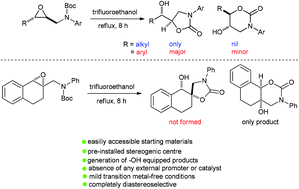Regioselectivity of the trifluoroethanol-promoted intramolecular N-Boc–epoxide cyclization towards 1,3-oxazolidin-2-ones and 1,3-oxazinan-2-ones†
Abstract
The intramolecular N-Boc–epoxide cyclization leading to the formation of 1,3-oxazolidin-2-one and 1,3-oxazinan-2-one derivatives has scarcely been reported in the literature. More specifically, the intramolecular cyclization of N-Boc aniline-tethered 2,3-disubstitued epoxides has never been disclosed. Herein, we demonstrate that this reaction could proceed in a diastereoselective fashion in refluxing trifluoroethanol, in the absence of any external promoter or catalyst. Substrates bearing an alkyl group at the C-3 position furnished 1,3-oxazolidin-2-ones in a completely regioselective fashion via 5-exo epoxide ring-opening cyclization, thereby paving the way to synthesize alkyl side chain-bearing analogs of the antidepressant drug toloxatone. On the other hand, replacing the alkyl group with an aryl group resulted in easily separable mixtures of 1,3-oxazolidin-2-ones and 1,3-oxazinan-2-ones, the former being obtained as the major products. Remarkably, a tetralin-bearing substrate underwent fully regioselective 6-endo ring closure to form the corresponding 1,3-oxazinan-2-one. Our present study on the intramolecular ring opening-cyclization of epoxides with a tethered N-Boc group is the most comprehensive to date and features broad substrate scope, mild transition metal-free conditions, excellent functional group tolerance, and scalability.

- This article is part of the themed collection: Synthetic methodology in OBC


 Please wait while we load your content...
Please wait while we load your content...